Welcome to the fascinating world of the Intermittent Fasting Diet Plan Indian, where we unlock the secrets of this revolutionary approach to wellness and weight management. Prepare to embark on an extraordinary voyage of self-discovery and transformation, as we delve into the art of intermittent fasting and its myriad of incredible benefits.
Before we dive into the heart of this transformative diet plan, let us take a moment to appreciate the wonders of intermittent fasting. Picture this: a world where your body becomes a well-oiled machine, functioning at its peak performance, and paving the way for a healthier, happier you. Intriguing, right?
Now, you might wonder what exactly is intermittent fasting. In essence, it is a lifestyle, a way of eating that involves alternating periods of eating and fasting. It’s not merely a diet; it’s a profound shift in how we nourish our bodies. By giving your digestive system regular breaks, intermittent fasting allows your body to rest, repair, and rejuvenate.
The benefits of intermittent fasting extend far beyond weight loss, though that is indeed one of its remarkable outcomes. Boosted energy levels, improved brain function, enhanced immune system, and even increased lifespan are just a few of the perks waiting to be claimed by those who embrace this lifestyle.
Intrigued? You should be! Our journey together has only just begun, and the wonders of intermittent fasting await your embrace. So, fasten your seatbelts and get ready to transform your life with the Intermittent Fasting Diet Plan. Your path to a healthier, happier you start now!
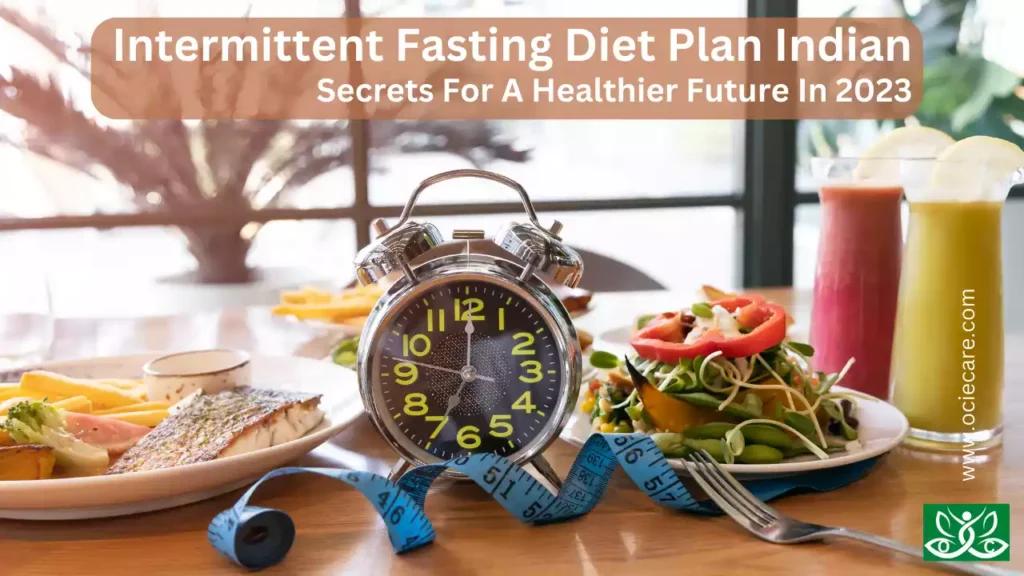
Intermittent Fasting Diet Plan Indian
What is Intermittent Fasting?
Intermittent fasting is a dietary approach that involves alternating periods of eating and fasting. It is not a traditional diet but rather a pattern of eating that cycles between periods of consumption and periods of abstaining from food. During the eating periods, individuals can eat their regular meals, while during the fasting periods, they refrain from eating or consume very few calories.
I. Goal:
- The primary goal of intermittent fasting is to allow the body to rest from the constant intake of food, giving it a chance to repair, regenerate, and optimize various physiological processes.
- There are several popular methods of intermittent fasting, each with its schedule and duration of fasting and eating windows.
II. Common Intermittent Fasting Methods:
a. 16/8 Method:
- This involves fasting for 16 hours a day and eating during an 8-hour window. For example, one might eat between 12:00 PM and 8:00 PM and fast from 8:00 PM to 12:00 PM the next day.
b. 5:2 Diet:
- In this approach, individuals eat normally for five days a week and restrict their calorie intake to about 500-600 calories for two non-consecutive days.
c. Eat-Stop-Eat:
- This method involves fasting for a full 24 hours once or twice a week, with no calorie intake during the fasting period.
d. Alternate-Day Fasting:
- As the name suggests, this method alternates between regular eating days and fasting days, where calorie intake is significantly reduced or eliminated.
e. OMAD (One Meal a Day) Method:
- OMAD involves fasting for approximately 23 hours and consuming all daily calories within a one-hour eating window.
Intermittent fasting has gained popularity for various reasons, including its potential to aid in weight loss, improve metabolic health, increase longevity, and offer other health benefits. It may also help regulate blood sugar levels, reduce inflammation, and promote brain health.
It’s important to note that intermittent fasting may not be suitable for everyone, especially pregnant or breastfeeding women, individuals with certain medical conditions, or those with a history of eating disorders.
As with any dietary change, it’s advisable to consult a healthcare professional before starting an intermittent fasting regimen to ensure it is safe and appropriate for individual needs and health conditions.
Empowering Benefits of Flexitarian Diet Living | Embrace the Plant-Meat Harmony
Different Types of Intermittent Fasting Diet Plan Indian
Different types of intermittent fasting methods can be adapted to suit the Indian lifestyle and dietary preferences. Indians have a rich and diverse culinary tradition, and intermittent fasting can be customized to align with cultural practices and food choices. Here are some intermittent fasting methods that can be followed by Indians:
1. 16/8 Method (Time-Restricted Eating):
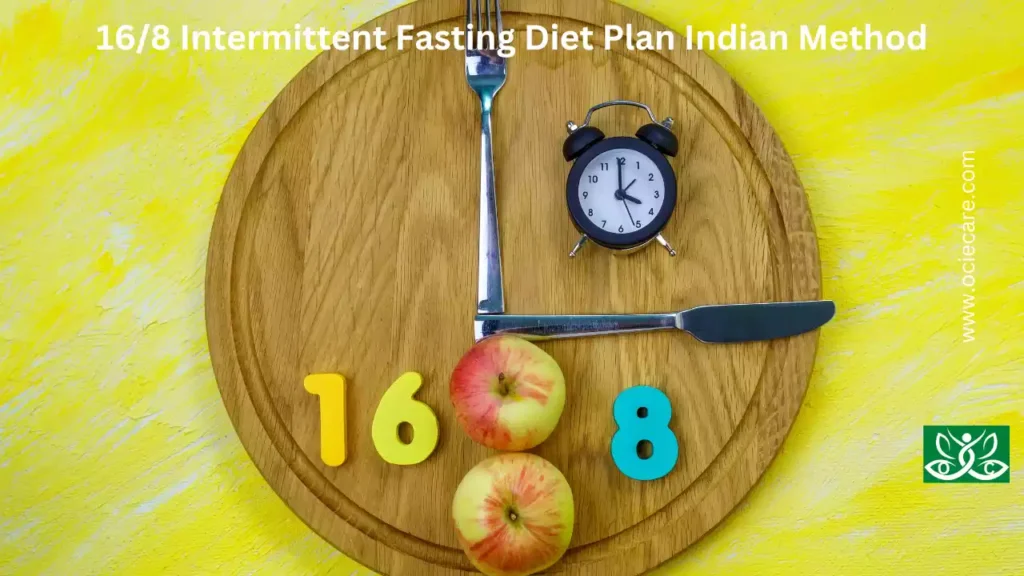
The 16/8 method involves fasting for 16 hours a day and restricting eating to an 8-hour window. This method is flexible and can be adapted to suit Indian meal timings.
- One can start fasting after dinner (around 8 PM) and break the fast with a late breakfast (around 12 PM) the next day.
- This approach allows individuals to enjoy two to three meals during the eating window, including traditional Indian breakfast, lunch, and dinner.
Sample Diet Chart for Intermittent Fasting Diet Plan Indian (16/8 Method) – Indian Cuisine:
This diet chart is a general example and can be adjusted based on individual dietary preferences, cultural practices, and health goals.
I. Eating Window: 12:00 PM to 8:00 PM
a. Breakfast (12:00 PM):
- Vegetable Upma (semolina cooked with mixed vegetables and spices)
- Fresh Fruit Salad (assorted seasonal fruits)
b. Lunch (2:30 PM):
- Rajma Masala (red kidney beans curry)
- Steamed Basmati Rice
- Cucumber Raita (cucumber and yogurt side dish)
- Mixed Green Salad
c. Snack (5:00 PM):
- Sprouts Chaat (assorted sprouts with onions, tomatoes, and spices)
- Herbal Tea or Black Coffee (without added sugar)
d. Dinner (7:30 PM):
- Palak Paneer (spinach and cottage cheese curry)
- Whole Wheat Roti (Indian flatbread)
- Moong Dal Tadka (split green gram lentil curry)
- Steamed Brown Rice
e. Post-Dinner (8:00 PM):
- Herbal Tea or Warm Turmeric Milk
f. Hydration:
- Drink plenty of water throughout the day, especially during the fasting period.
- Stay hydrated with herbal teas, coconut water, and infused water during the eating window.
II. Important Tips:
- Focus on whole, unprocessed foods, and limit added sugars and unhealthy fats.
- Ensure a good balance of macronutrients (proteins, carbohydrates, and fats) in your meals.
- Listen to your body’s hunger and fullness cues during the eating window.
- Customize the diet chart based on your dietary preferences and cultural food choices.
- Adjust the eating window to suit your schedule and lifestyle while maintaining the 16-hour fasting duration.
Remember, intermittent fasting is not about calorie restriction but rather about optimizing the timing of meals to support overall health.
This sample diet chart provides a general idea of how traditional Indian meals can be incorporated into Intermittent Fasting Diet Plan Indian methods.
For personalized guidance, consider consulting a registered dietitian or healthcare professional to create a diet plan tailored to your individual needs and goals.
2. 5:2 Method:
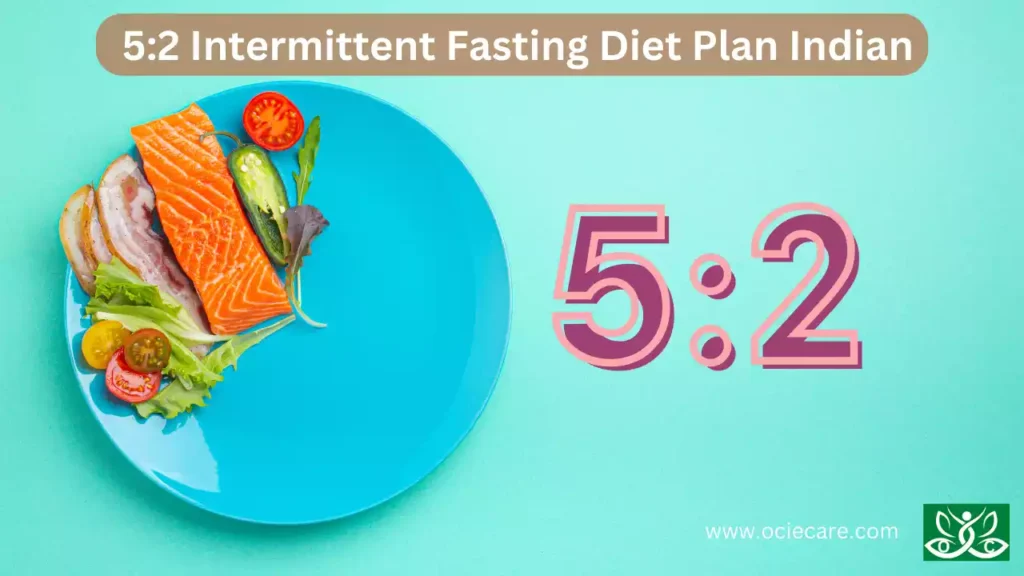
The 5:2 method involves eating normally for five days a week and restricting calorie intake to 500-600 calories for two non-consecutive days.
- On fasting days, Indian meals can consist of lighter options like vegetable soups, salads, dals, and yogurt-based dishes.
- On regular eating days, individuals can enjoy a balanced diet with a mix of traditional Indian meals.
Sample Diet Chart for Intermittent Fasting Diet Plan Indian (5:2 Method) – Indian Cuisine:
This diet chart is a general example of a 5:2 intermittent fasting method with two fasting days. Adjust the fasting days according to your preference and schedule.
I. Fasting Days (Consume 500-600 Calories):
Fasting Day 1:
a. Breakfast (10:00 AM):
- Herbal Tea or Black Coffee (without added sugar) – 0 calories
b. Lunch (1:00 PM):
- Mixed Vegetable Soup – 100 calories
- Cucumber and Tomato Salad – 50 calories
c. Snack (4:00 PM):
- Carrot Sticks with Hummus – 100 calories
- Herbal Tea or Green Tea (without added sugar) – 0 calories
d. Dinner (7:00 PM):
- Grilled Paneer (Cottage Cheese) – 150 calories
- Steamed Broccoli – 50 calories
- Herbal Tea or Chamomile Tea (without added sugar) – 0 calories
Total Calories: 450 calories
Fasting Day 2:
a. Breakfast (9:00 AM):
- Herbal Tea or Black Coffee (without added sugar) – 0 calories
b. Lunch (12:00 PM):
- Tomato and Cucumber Salad – 50 calories
- Vegetable Clear Soup – 100 calories
c. Snack (3:00 PM):
- Sliced Apple with Almond Butter – 100 calories
- Herbal Tea or Peppermint Tea (without added sugar) – 0 calories
d. Dinner (6:00 PM):
- Grilled Tofu with Bell Peppers – 150 calories
- Spinach Salad with Lemon Dressing – 50 calories
- Herbal Tea or Ginger Tea (without added sugar) – 0 calories
Total Calories: 400 calories
II. Regular Eating Days (Non-Fasting Days):
a. Breakfast (10:00 AM):
- Vegetable Poha (Flattened rice with vegetables and spices) – 250 calories
b. Lunch (1:00 PM):
- Chickpea Curry (Chana Masala) – 250 calories
- Steamed Basmati Rice – 150 calories
- Cucumber Raita (Cucumber and Yogurt Side Dish) – 100 calories
c. Snack (4:00 PM):
- Assorted Nuts (Almonds, Walnuts, Cashews) – 150 calories
- Herbal Tea or Masala Chai (without added sugar) – 0 calories
d. Dinner (7:00 PM):
- Mixed Vegetable Stir-Fry – 200 calories
- Whole Wheat Roti (Indian flatbread) – 100 calories
e. Post-Dinner (8:00 PM):
- Herbal Tea or Warm Turmeric Milk – 0 calories
III. Hydration:
- Drink plenty of water throughout the day, especially during the fasting period.
- Stay hydrated with herbal teas, coconut water, and infused water during the eating window.
IV. Important Tips:
- Focus on nutrient-dense foods during the eating window to meet your nutritional needs.
- Customize the diet chart based on your dietary preferences and cultural food choices.
- Ensure a good balance of macronutrients (proteins, carbohydrates, and fats) in your meals.
- Stay mindful of portion sizes and avoid excessive sugars and unhealthy fats.
- Consult a registered dietitian or healthcare professional for personalized guidance and support.
Remember that intermittent fasting is a lifestyle approach and should be tailored to your individual needs and health goals.
This sample diet chart provides a general idea of how traditional Indian meals can be incorporated into the 5:2 Intermittent Fasting Diet Plan Indian method. Adjust the calorie intake and fasting days as needed to suit your preferences and lifestyle.
3. Eat-Stop-Eat:
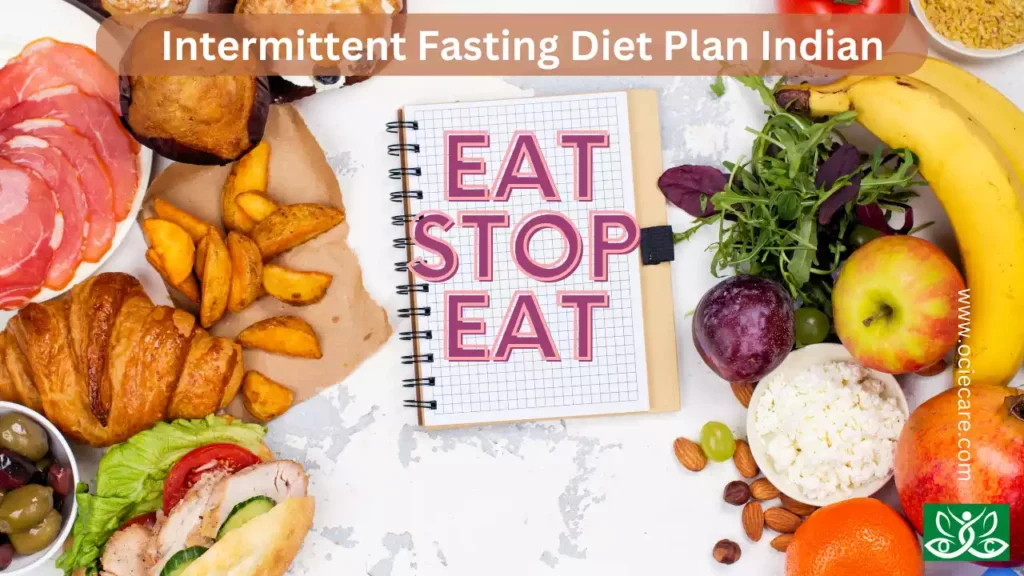
The Eat-Stop-Eat method involves fasting for a full 24 hours once or twice a week. For Indians, this can be adapted by starting the fast after dinner and fasting until dinner the next day.
- Fasting days can include plenty of water, herbal teas, and low-calorie beverages, and the following day can begin with a nourishing meal like vegetable stew or a nutritious smoothie.
Sample Diet Chart for Intermittent Fasting Diet Plan Indian (Eat-Stop-Eat Method) – Indian Cuisine:
The Eat-Stop-Eat method involves fasting for a full 24 hours once or twice a week. Choose fasting days that suit your schedule and preferences. This sample diet chart provides options for both fasting and eating days.
I. Fasting Day:
a. Dinner (7:00 PM – Last Meal before Fasting):
- Grilled Tandoori Chicken (or Paneer for vegetarians) – 150 calories
- Cucumber and Mint Raita – 50 calories
- Herbal Tea or Warm Water – 0 calories
b. Fasting Period (7:00 PM to 7:00 PM the next day):
- Consume only water, herbal teas, black coffee (without added sugar), and non-caloric beverages during the fasting period.
c. Breaking the Fast (7:00 PM – Next Day):
- Vegetable Clear Soup – 100 calories
- Mixed Green Salad – 50 calories
d. Dinner (8:00 PM):
- Grilled Fish with Indian Spices – 200 calories
- Stir-Fried Vegetables – 100 calories
- Herbal Tea or Black Coffee (without added sugar) – 0 calories
Total Calories: 500 calories
II. Regular Eating Day:
a. Breakfast (8:00 AM):
- Vegetable Upma (semolina cooked with mixed vegetables and spices) – 250 calories
b. Lunch (1:00 PM):
- Chickpea Curry (Chana Masala) – 250 calories
- Steamed Basmati Rice – 150 calories
- Cucumber Raita (Cucumber and Yogurt Side Dish) – 100 calories
c. Snack (4:00 PM):
- Assorted Nuts (Almonds, Walnuts, Cashews) – 150 calories
- Herbal Tea or Masala Chai (without added sugar) – 0 calories
d. Dinner (7:00 PM):
- Mixed Vegetable Stir-Fry – 200 calories
- Whole Wheat Roti (Indian flatbread) – 100 calories
e. Post-Dinner (8:00 PM):
- Herbal Tea or Warm Turmeric Milk – 0 calories
Total Calories: Approximately 1000 calories
III. Hydration:
- Drink plenty of water throughout the day, especially during the fasting period.
- Stay hydrated with herbal teas, coconut water, and infused water during the eating window.
IV. Important Tips:
- Ensure nutrient-dense meals during the eating window to meet your nutritional needs.
- Customize the diet chart based on your dietary preferences and cultural food choices.
- On fasting days, listen to your body’s signals and stay hydrated with non-caloric beverages.
- On regular eating days, focus on balanced meals with a mix of proteins, carbohydrates, and healthy fats.
- Consult a registered dietitian or healthcare professional for personalized guidance and support.
Remember that the Eat-Stop-Eat method involves full-day fasting, and it’s crucial to prioritize hydration and nutrient intake during eating windows.
This sample diet chart provides a general idea of how traditional Indian meals can be incorporated into the Eat-Stop-Eat Intermittent Fasting Diet Plan Indian method. Adjust the timing and food choices according to your personal preferences and lifestyle.
Keto Diet for Weight Loss and Wellness | 08 Week Challenge
4. Alternate-Day Fasting:
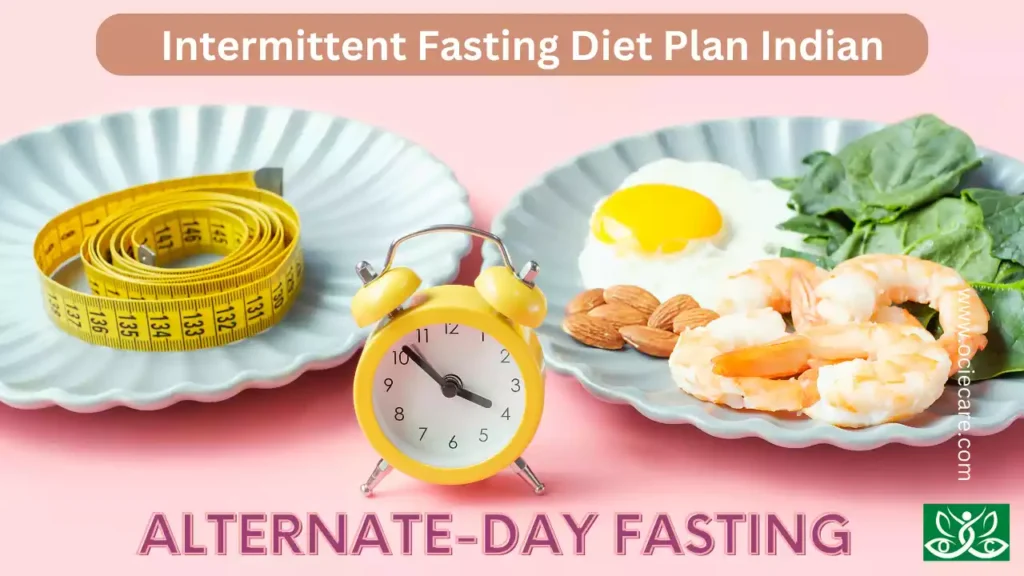
Alternate-day fasting involves alternating between fasting days and regular eating days. On fasting days, calorie intake is significantly reduced or restricted, while on regular eating days, individuals can consume their usual meals.
- Indians can choose traditional vegetarian meals rich in vegetables, lentils, and whole grains for their eating days. On fasting days, lighter meals like soups, salads, and fruits can be consumed.
Sample Diet Chart for Intermittent Fasting Diet Plan Indian (Alternate-Day Fasting Method) – Indian Cuisine:
The Alternate-Day Fasting method involves alternating between fasting days and regular eating days. This sample diet chart provides options for both fasting and eating days.
I. Fasting Day:
a. Breakfast (9:00 AM):
- Herbal Tea or Black Coffee (without added sugar) – 0 calories
b. Lunch (12:00 PM):
- Mixed Vegetable Clear Soup – 100 calories
- Cucumber and Tomato Salad – 50 calories
c. Snack (3:00 PM):
- Carrot Sticks with Hummus – 100 calories
- Herbal Tea or Green Tea (without added sugar) – 0 calories
d. Dinner (6:00 PM):
- Grilled Tofu with Bell Peppers – 150 calories
- Spinach Salad with Lemon Dressing – 50 calories
- Herbal Tea or Chamomile Tea (without added sugar) – 0 calories
Total Calories: 400 calories
II. Regular Eating Day:
a. Breakfast (8:00 AM):
- Vegetable Poha (Flattened rice with vegetables and spices) – 250 calories
b. Lunch (1:00 PM):
- Chickpea Curry (Chana Masala) – 250 calories
- Steamed Basmati Rice – 150 calories
- Cucumber Raita (Cucumber and Yogurt Side Dish) – 100 calories
c. Snack (4:00 PM):
- Assorted Nuts (Almonds, Walnuts, Cashews) – 150 calories
- Herbal Tea or Masala Chai (without added sugar) – 0 calories
d. Dinner (7:00 PM):
- Mixed Vegetable Stir-Fry – 200 calories
- Whole Wheat Roti (Indian flatbread) – 100 calories
e. Post-Dinner (8:00 PM):
- Herbal Tea or Warm Turmeric Milk – 0 calories
Total Calories: Approximately 1000 calories
III. Hydration:
- Drink plenty of water throughout the day, especially during the fasting period.
- Stay hydrated with herbal teas, coconut water, and infused water during the eating window.
IV. Important Tips:
- Focus on nutrient-dense meals during the eating window to meet your nutritional needs.
- Customize the diet chart based on your dietary preferences and cultural food choices.
- On fasting days, listen to your body’s signals and stay hydrated with non-caloric beverages.
- On regular eating days, ensure balanced meals with a mix of proteins, carbohydrates, and healthy fats.
- Consult a registered dietitian or healthcare professional for personalized guidance and support.
Remember that Alternate-Day Fasting involves alternating between fasting and regular eating days.
This sample diet chart provides a general idea of how traditional Indian meals can be incorporated into the Alternate-Day Intermittent Fasting Diet Plan Indian method. Adjust the timing and food choices according to your personal preferences and lifestyle.
Also, consider choosing nutrient-dense foods to meet your nutritional requirements during eating days. Always prioritize your health and well-being when practicing intermittent fasting.
5. OMAD (One Meal a Day) Method:
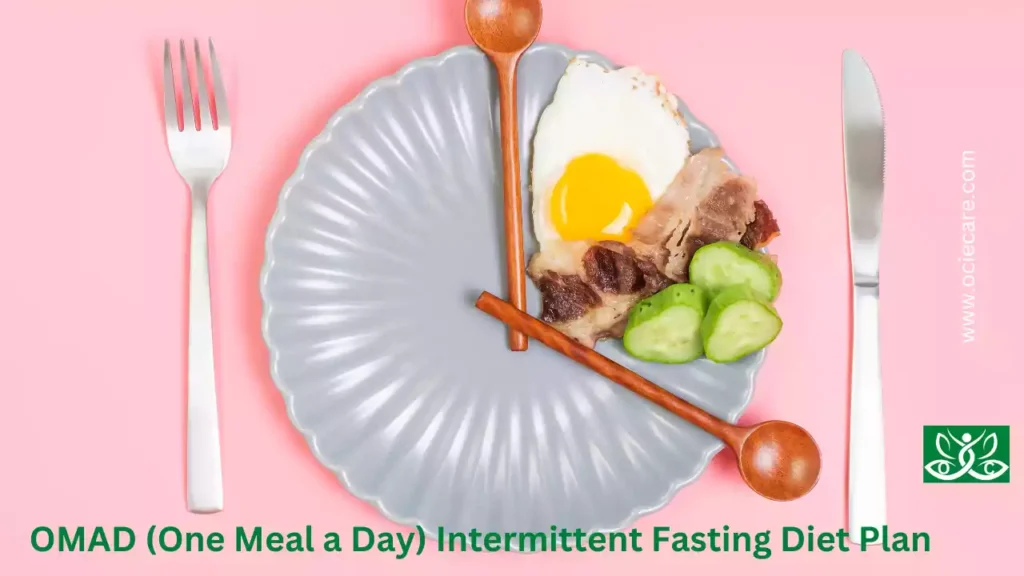
OMAD involves fasting for approximately 23 hours and consuming all daily calories within a one-hour eating window.
- Indians can enjoy a wholesome and elaborate meal that includes a variety of dishes, representing different regions and flavors of Indian cuisine.
- This approach allows individuals to savor a traditional Indian thali or platter comprising grains, lentils, vegetables, and desserts.
Sample Diet Chart for Intermittent Fasting Diet Plan Indian (OMAD Method) – Indian Cuisine:
The OMAD (One Meal a Day) method involves fasting for approximately 23 hours and consuming all daily calories within a one-hour eating window. This sample diet chart provides options for a wholesome and balanced OMAD meal with traditional Indian dishes.
I. Eating Window: 7:00 PM to 8:00 PM
OMAD Meal:
a. Appetizer (7:00 PM):
- Lentil Soup (Dal Soup) – 100 calories
b. Main Course (7:15 PM):
- Vegetable Biryani – 300 calories
- Palak Paneer (Spinach and Cottage Cheese Curry) – 200 calories
- Tandoori Chicken (or Grilled Tofu for vegetarians) – 250 calories
c. Accompaniments (7:30 PM):
- Cucumber Raita (Cucumber and Yogurt Side Dish) – 100 calories
- Assorted Pickles – 50 calories
- Papad (Indian crispy flatbread) – 50 calories
d. Dessert (7:45 PM):
- Fruit Salad (assorted seasonal fruits) – 100 calories
e. Post-Meal Beverage (8:00 PM):
- Herbal Tea or Warm Turmeric Milk – 0 calories
Total Calories: Approximately 1150 calories
II. Hydration:
- Drink plenty of water throughout the day, especially during the fasting period.
- Stay hydrated with herbal teas, coconut water, and infused water during the eating window.
III. Important Tips:
- Ensure the OMAD meal includes a mix of proteins, carbohydrates, healthy fats, and fiber.
- Customize the diet chart based on your dietary preferences and cultural food choices.
- Opt for nutrient-dense foods to meet your nutritional requirements in a single meal.
- Listen to your body’s hunger and fullness cues during the OMAD eating window.
- Prioritize a balanced and satisfying meal to support your energy needs for the day.
- Consult a registered dietitian or healthcare professional for personalized guidance and support.
Remember that the OMAD method involves consuming all daily calories in one meal. This sample diet chart provides a general idea of how traditional Indian dishes can be incorporated into the OMAD approach.
Adjust the meal composition and timing based on your individual preferences and lifestyle. While practicing OMAD, make sure to nourish your body with a balanced and wholesome meal that meets your nutritional needs.
Therefore, when following any Intermittent Fasting Diet Plan Indian method, it is crucial to prioritize balanced nutrition, especially during the eating windows. Indian meals can include a variety of fruits, vegetables, legumes, dairy, and whole grains to provide essential nutrients.
Additionally, listening to the body’s cues and customizing the fasting approach to individual preferences and cultural practices is key to making intermittent fasting a sustainable and enjoyable part of the Indian lifestyle.
As with any dietary change, consulting a healthcare professional or registered dietitian is recommended to ensure that intermittent fasting is safe and suitable for individual health needs.
Benefits And Potential Risks of Intermittent Fasting
I. Benefits of Intermittent Fasting:
a. Weight Loss and Fat Loss:
- Intermittent fasting can be an effective tool for weight management as it helps create a calorie deficit, leading to fat loss.
- It also supports the preservation of lean muscle mass.
b. Improved Insulin Sensitivity:
- Intermittent fasting may enhance insulin sensitivity, reducing the risk of type 2 diabetes and promoting better blood sugar regulation.
c. Heart Health:
- Some studies suggest that intermittent fasting can lower LDL cholesterol, triglycerides, blood pressure, and other risk factors associated with cardiovascular diseases.
d. Cellular Repair and Autophagy:
- During fasting, the body initiates autophagy, a process where damaged cells are removed and replaced with newer, healthier ones, promoting cellular repair and rejuvenation.
e. Brain Health and Mental Clarity:
- Intermittent fasting may stimulate the production of brain-derived neurotrophic factor (BDNF), which supports brain health, improves cognitive function, and reduces the risk of neurodegenerative diseases.
f. Increased Energy Levels:
- Fasting can lead to increased adrenaline and noradrenaline levels, promoting higher energy levels and alertness.
g. Longevity and Anti-Aging Effects:
- Some animal studies suggest that intermittent fasting may extend lifespan and slow down the aging process due to its impact on cellular repair and stress resistance.
h. Enhanced Immune System:
- Intermittent fasting may stimulate the production of white blood cells and boost the body’s immune response, improving resistance to infections and diseases.
i. Simplicity and Flexibility:
- Intermittent fasting is relatively easy to follow, as it does not require complex meal planning or special foods.
- It can be adapted to fit individual schedules and lifestyles.
How Vegan Diet Helps to Improve | Magically On Body & Mind, Digestion & Weight
II. Potential Risks of Intermittent Fasting:
a. Nutrient Deficiencies:
- If not done correctly, intermittent fasting may lead to inadequate nutrient intake, especially if individuals do not consume a balanced diet during their eating windows.
b. Hunger and Discomfort:
- Fasting periods can cause hunger, irritability, and discomfort, especially when first starting an intermittent fasting regimen.
c. Eating Disorders:
- Individuals with a history of eating disorders may be at risk of developing or exacerbating disordered eating patterns with intermittent fasting.
d. Blood Sugar Imbalances:
- Some people, especially those with diabetes or hypoglycemia, may experience blood sugar fluctuations during fasting, leading to symptoms like dizziness or fainting.
e. Fatigue and Weakness:
- Prolonged fasting without adequate nutrition can lead to fatigue, weakness, and reduced physical and mental performance.
f. Sleep Disturbances:
- Intermittent fasting might affect sleep patterns, leading to difficulties falling or staying asleep for some individuals.
g. Gastrointestinal Issues:
- Fasting can cause digestive disturbances, such as acid reflux or indigestion, especially when overeating during eating windows.
h. Social Challenges:
- Social events and gatherings centered around food can be challenging during fasting periods, impacting social interactions.
Intermittent fasting may not be suitable for certain groups, including pregnant or breastfeeding women, children, individuals with a history of eating disorders, or those with specific medical conditions.
It is crucial to consult with a healthcare professional or a registered dietitian before starting an intermittent fasting plan to determine if it is safe and appropriate for individual health needs.
How to get started with intermittent fasting?
Intermittent fasting can be a beneficial dietary approach, but it’s essential to ease into it gradually and choose a method that suits your lifestyle and health goals. Here’s a step-by-step guide to help you get started:
I. Choose the Right Method:
- There are various intermittent fasting methods, such as the 16/8 method, 5:2 diet, Eat-Stop-Eat, and alternate-day fasting.
- Consider your daily schedule, eating habits, and personal preferences before selecting a method that aligns with your lifestyle.
II. Consult a Healthcare Professional:
- Before beginning any fasting regimen, it’s crucial to consult with a healthcare professional or a registered dietitian, especially if you have any underlying health conditions or concerns.
III. Set Clear Goals:
- Define your goals for intermittent fasting.
- Whether it’s weight loss, improved metabolic health, or enhanced mental clarity, having clear objectives will help you stay motivated.
IV. Start with a Small Fasting Window:
- If you’re new to fasting, begin with a shorter fasting window, such as 12 hours, and gradually increase it over time as you become more comfortable.
V. Stay Hydrated:
- Drink plenty of water during fasting periods to stay hydrated and help reduce feelings of hunger.
VI. Choose Nutrient-Dense Foods:
- Focus on consuming nutrient-dense foods during your eating windows to ensure you get essential vitamins and minerals.
- Incorporate whole grains, lean proteins, fruits, vegetables, and healthy fats into your meals.
VII. Avoid Overeating:
- During your eating windows, be mindful of portion sizes and avoid overeating.
- Pay attention to your body’s hunger cues and stop eating when you feel satisfied.
VIII. Plan Your Meals:
- Plan your meals ahead of time to ensure you have balanced and satisfying options available during your eating windows.
- This can help you avoid making unhealthy food choices when hunger strikes.
IX. Listen to Your Body:
- Be attentive to how your body responds to intermittent fasting.
- If you experience adverse effects or extreme discomfort, consider adjusting your fasting schedule or method.
X. Be Patient and Persistent:
- It may take some time for your body to adjust to intermittent fasting.
- Be patient with yourself and stay persistent in your efforts.
- Results may not be immediate, but with consistency, you are likely to see positive changes over time.
XI. Track Your Progress:
- Keep a journal to track your fasting periods, eating patterns, and any changes you observe in your body and overall well-being.
- This can help you stay accountable and identify what works best for you.
XII. Stay Flexible:
- Life events and circumstances may occasionally interfere with your fasting schedule.
- It’s okay to be flexible and adapt your fasting routine when needed.
- The key is to find a sustainable approach that fits your life.
Remember, intermittent fasting may not be suitable for everyone, and individual experiences can vary. If you have any concerns or encounter challenges along the way, seek guidance from a healthcare professional or a registered dietitian to ensure you are implementing intermittent fasting safely and effectively.
Tips for a Successful Intermittent Fasting Journey
Intermittent fasting can be a rewarding and effective approach to improving your overall health and well-being. To ensure a successful intermittent fasting journey, consider implementing the following tips:
I. Start Gradually:
- If you’re new to intermittent fasting, begin with a shorter fasting window, such as 12 hours, and gradually increase it as you become more comfortable with the fasting process.
II. Choose the Right Method:
- Select an intermittent fasting method that aligns with your lifestyle, schedule, and health goals.
- Experiment with different methods to find the one that suits you best.
III. Stay Hydrated:
- Drink plenty of water during fasting periods to stay hydrated and curb feelings of hunger.
IV. Focus on Nutrient-Dense Foods:
- Opt for nutrient-dense foods during your eating windows to ensure you get essential vitamins and minerals.
- Include a variety of whole grains, lean proteins, fruits, vegetables, and healthy fats in your meals.
V. Plan Your Meals:
- Plan your meals ahead of time to avoid making impulsive and unhealthy food choices during eating windows.
VI. Listen to Your Body:
- Pay attention to your body’s hunger cues and eat until you feel satisfied during your eating windows. Avoid overeating.
VII. Stay Busy:
- Keep yourself occupied during fasting periods to distract yourself from hunger and cravings.
- Engage in activities, hobbies, or work to pass the time.
VIII. Manage Stress:
- High-stress levels can impact your fasting journey.
- Practice stress-reducing techniques such as meditation, deep breathing exercises, or yoga.
IX. Get Enough Sleep:
- Prioritize adequate sleep to support your body’s natural rhythms and improve overall well-being.
X. Exercise Regularly:
- Incorporate regular physical activity into your routine. Exercise can help control appetite, improve mood, and boost metabolism.
XI. Be Patient:
- Results may take time to manifest. Be patient with yourself and stay committed to the process.
XII. Stay Consistent:
- Consistency is key to successful intermittent fasting. Stick to your chosen fasting schedule as closely as possible.
XIII. Avoid Unhealthy Foods:
- During your eating windows, steer clear of highly processed and sugary foods.
- Focus on whole, unprocessed foods instead.
XIV. Stay Accountable:
- Consider sharing your intermittent fasting journey with a friend or joining a supportive community to stay accountable and motivated.
XV. Monitor Progress:
- Keep a journal to track your fasting periods, meals, and any changes you experience.
- This will help you understand what works best for you.
XVI. Seek Professional Advice:
- If you have any health concerns or medical conditions, consult with a healthcare professional or a registered dietitian before starting intermittent fasting.
XVII. Stay Flexible:
- Life events and special occasions may arise, disrupting your fasting schedule. Stay flexible and adapt your fasting routine when necessary.
Remember that intermittent fasting may not be suitable for everyone, and individual experiences can vary. If you encounter any adverse effects or difficulties, consult a healthcare professional to ensure your fasting plan is safe and tailored to your specific needs.
Ref: World Health Organization (WHO) Nutrition (CLICK HERE) – Access reliable global nutrition information and resources.
Conclusion:
The Intermittent Fasting Diet Plan Indian tailored for the Indian lifestyle offers a flexible and effective approach to achieving health and wellness goals. Incorporating traditional Indian cuisine into various intermittent fasting methods allows individuals to experience the benefits of fasting while embracing their cultural food preferences.
Whether following the 16/8, 5:2, Eat-Stop-Eat, Alternate-Day Fasting, or OMAD method, it is crucial to prioritize balanced nutrition during eating windows. By focusing on nutrient-dense foods, staying hydrated, and listening to the body’s cues, intermittent fasting can be a sustainable and enjoyable part of an Indian’s journey toward improved metabolism, weight management, and overall well-being.
FAQs
Q. Is intermittent fasting safe for Indians following traditional diets?
A. Yes, intermittent fasting can be safe for Indians following traditional diets when done correctly. It is essential to ensure adequate nutrient intake during eating windows and maintain hydration levels. Consulting a healthcare professional or registered dietitian is recommended, especially for those with specific health conditions or dietary restrictions.
Q. Can I follow intermittent fasting if I have diabetes or other health conditions?
A. Intermittent fasting may not be suitable for everyone, especially those with diabetes or certain health conditions. Individuals with underlying health concerns should consult a healthcare professional before starting any fasting regimen to ensure it aligns with their medical needs.
Q. Can I continue with my cultural food preferences during intermittent fasting?
A. Absolutely! Intermittent fasting can be customized to suit cultural food preferences, including traditional Indian meals. By choosing nutrient-rich options and adapting fasting methods to eating schedules, individuals can enjoy their favorite dishes while practicing intermittent fasting.
Q. Can intermittent fasting help with weight loss for Indians?
A. Intermittent fasting can be an effective tool for weight management when combined with a balanced diet and regular physical activity. By promoting a calorie deficit during fasting periods and making healthier food choices during eating windows, weight loss can be achieved.
Q. How do I stay hydrated during fasting periods?
A. Staying hydrated is crucial during fasting periods. Consume plenty of water, herbal teas, and non-caloric beverages throughout the day to prevent dehydration. However, avoid sugary or high-calorie drinks, as they may break the fast.
Q. Should I exercise while intermittent fasting?
A. Light to moderate exercise is generally safe during intermittent fasting. However, intense workouts may be better suited during eating windows to ensure sufficient energy and nutrient intake. Listen to your body and adjust exercise intensity accordingly.
Q. How do I manage hunger during fasting periods?
A. Hunger during fasting periods is normal. Stay hydrated, consume non-caloric beverages, and keep busy to distract yourself from hunger. Over time, the body may adapt to the fasting schedule, and hunger may become more manageable.
Q. Can I continue taking medications while intermittent fasting?
A. If you are on medications, consult your healthcare provider before starting intermittent fasting. They can advise on how to adjust medication schedules to ensure safety and effectiveness.
Q. Is intermittent fasting suitable for pregnant or breastfeeding women?
A. Intermittent fasting is not recommended for pregnant or breastfeeding women, as they have increased nutrient needs. Proper nutrition is crucial during these stages to support the health of both the mother and the baby.
Q. Can intermittent fasting be a long-term lifestyle approach?
A. Intermittent fasting can be a sustainable long-term lifestyle approach for some individuals. However, it is essential to listen to your body and make adjustments as needed. Regular check-ins with a healthcare professional or registered dietitian can ensure a safe and successful intermittent fasting journey.
daxktilogibigibi.f6yi4hQ89sw6
astrapophobia xyandanxvurulmus.uHgn2sZKXTRs